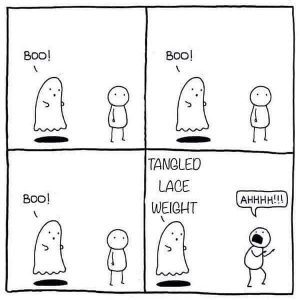Jennifer Crusie's Blog, page 139
December 7, 2019
Cherry Saturday, December 7, 2019
 Today is Oh Thank God I Have The Internet Back Day.
Today is Oh Thank God I Have The Internet Back Day.
It’s also Pear Month, but I hate pears, so you all will have to take that one.
The post Cherry Saturday, December 7, 2019 appeared first on Argh Ink.

December 6, 2019
Argh Author: Krissie has a New Book, Return to Christmas
 Krissie, my partner in crime and also Anne Stuart, has a wonderful new Christmas book out, called Return to Christmas. A young woman gets stuck in 1947 Macy’s and falls in love – you know the drill. But it’s a book of her heart and she loves it to pieces (and so do most readers). Other Cherry beta readers and I read it and loved it, so go hit that buy button. (Sorry for the abbreviated entry, I’m using Friendly’s WiFi and eating breakfast, so this is a hit and run.)
Krissie, my partner in crime and also Anne Stuart, has a wonderful new Christmas book out, called Return to Christmas. A young woman gets stuck in 1947 Macy’s and falls in love – you know the drill. But it’s a book of her heart and she loves it to pieces (and so do most readers). Other Cherry beta readers and I read it and loved it, so go hit that buy button. (Sorry for the abbreviated entry, I’m using Friendly’s WiFi and eating breakfast, so this is a hit and run.)
The post Argh Author: Krissie has a New Book, Return to Christmas appeared first on Argh Ink.

This is a Good Book Thursday on Friday
Sorry. Power is back on, still no internet. ARGH.
ETA: 5:23. I HAVE INTERNET BACK.
My god, that was horrible.
The post This is a Good Book Thursday on Friday appeared first on Argh Ink.

December 4, 2019
Working Wednesday, December 4, 2019
 I am clearing out my stash this week. Finding many wonderful things but also the occasional yarn barf of a skein that unwound itself while I wasn’t looking. Most of the time I just patiently untangle it while I watch TV, but sometimes there’s just no way. If it’s lace weight, for example. But I’m getting it sorted into weights so I know where everything is, and I’ve got a big bag of yarn to hand off to Krissie next time she comes, and I have many many projects planned, so I’m working. Also there’s that book I have to finish that I have been obsessing over. Finally decided that I needed a white board on my one big plain living room wall more than I need a TV so I can see the damn thing (book not wall) all at once. My plan for December: FINISH STUFF.
I am clearing out my stash this week. Finding many wonderful things but also the occasional yarn barf of a skein that unwound itself while I wasn’t looking. Most of the time I just patiently untangle it while I watch TV, but sometimes there’s just no way. If it’s lace weight, for example. But I’m getting it sorted into weights so I know where everything is, and I’ve got a big bag of yarn to hand off to Krissie next time she comes, and I have many many projects planned, so I’m working. Also there’s that book I have to finish that I have been obsessing over. Finally decided that I needed a white board on my one big plain living room wall more than I need a TV so I can see the damn thing (book not wall) all at once. My plan for December: FINISH STUFF.
What are you up to?
The post Working Wednesday, December 4, 2019 appeared first on Argh Ink.

December 1, 2019
It’s December. Try To Be Happy Anyway.
 Welcome to December! If you’re in the US, that means hearing “Santa Baby” and “All I Want For Christmas Is You” at the supermarket while you’re trying to buy bok choy and considering the merits of Oreos vs Grasshoppers (buy both). It also means hearing the Christmas Nuts screaming about the audacity of Other Holidays being celebrated in preference to Our Lord’s Birthday Party (aka The War on Christmas) because America is now the land of the free-ish and home of the paranoid. Ah, for Christmas past, when my all my relatives would get drunk and take my allowance off me at poker (on the up side, I was damn good at poker by the time I was twelve). Or last year, when Melania Trump did the weirdest decorated White House in history (remember that creepy red forest? Evocative of both The Handmaid’s Tale and menstruation). Sigh.
Welcome to December! If you’re in the US, that means hearing “Santa Baby” and “All I Want For Christmas Is You” at the supermarket while you’re trying to buy bok choy and considering the merits of Oreos vs Grasshoppers (buy both). It also means hearing the Christmas Nuts screaming about the audacity of Other Holidays being celebrated in preference to Our Lord’s Birthday Party (aka The War on Christmas) because America is now the land of the free-ish and home of the paranoid. Ah, for Christmas past, when my all my relatives would get drunk and take my allowance off me at poker (on the up side, I was damn good at poker by the time I was twelve). Or last year, when Melania Trump did the weirdest decorated White House in history (remember that creepy red forest? Evocative of both The Handmaid’s Tale and menstruation). Sigh.
OTOH, I just bought myself a fuck-ton of yarn for Christmas, and that makes me deliriously happy.
What made you happy this week? (Besides the Drifters, I mean.)
The post It’s December. Try To Be Happy Anyway. appeared first on Argh Ink.

November 30, 2019
Cherry Saturday, November 30, 2019
Today is Computer Security Day. Change your passwords. Or not.
Hey, it was this or National Meth Awareness Day. Which, come to think of it, might have been better thanks to South Dakota’s new anti-meth campaign. At least I think it’s anti-meth. Some of those people look really nice . . .

I cannot understand how an entire government paid millions for this campaign and nobody ever said “Uh, wait . . .” But it makes me laugh, so points for that.
The post Cherry Saturday, November 30, 2019 appeared first on Argh Ink.

November 29, 2019
Questionable:How do we know when it’s okay to Tell instead of Show?
 Olga asked:
Olga asked:
The old writers’ dilemma of ‘show’ vs. ‘tell’. All the writing teachers and textbooks instruct us: “show, not tell,” but many successful writers use ‘tell’ a lot. Georgette Heyer is one of them. There is a lot of ‘tell’ in her novels. I’m not even talking about Jane Austen and other old-timers.
Did this demand of ‘show not tell’ change with time. What was allowed 50 years ago isn’t recommended today? Or are there some universal guidelines? How do we know when ‘tell’ is okay? And how much of it?
First, you can do anything you want. It’s your book. Seriously, if it feels right to tell, tell.
Second, on any rule, look at what’s behind it. That is, look at the problem it’s trying to solve. For a lot of writers, especially beginning writers, the concept that a reader is a collaborator is ludicrous. The assumption is that the reader just sits there and receives the story as if she were watching a movie. But the reader is always a co-writer, moving into the white space with her own experiences, thoughts, biases, desires. The writer who tells the reader exactly what’s going on, doesn’t give her room to inhabit and interpret the story. That is, she doesn’t show an interaction between John and Jane, she just says, “John and Jane hate each other.” It kills the immediacy of the book and makes it hard for the reader to attach to the story. But you can have it both ways, reader involvement and authorial intrusion to tell the reader things, depending on your Point of View.
Third, point-of-view is the key here.
• First person point of view socks the reader into the POV character’s head, so that POV character is telling everything that happens, BUT she’s telling it through her eyes, putting her character on the page. The reader can connect to her because she is her (as long as the character is somebody she wants to connect to). So the act of telling the story to the reader is actually a function of characterization.
• Third person omniscient point of view is the narrator as God, removed from the action, seeing and telling everything. This is Pratchett and to a lesser extent, Heyer. As long as the narrator is (like the first person narrator) somebody whose voice and worldview we like, we’ll put up with quite a bit of description (Pratchett’s descriptions of the River Ankh, for example), commentary, and explanation because we just like that narrator; it’s like sitting down with a great storyteller.
• Third person limited is where Telling trips up authors because third person is told from a distance through one person’s PoV per scene. That means that as the reader, we’re observing the actions, speech and thoughts of characters and forming our own conclusions, and thereby becoming a co-author of the story. So when the story stops and there’s a long stretch of telling how people thought or what they were doing or what the place they’re in looks like, the questions becomes “Who’s saying this stuff?” There’s no God the narrator telling the story or a first person character telling the story, there is no narrator at all in third limited. So any telling is a break in the willing suspension of disbelief: “I was experiencing this story and then some voice came in and started telling me things . . .”
Usually the problem occurs when somebody who’s using third limited wants to make sure something is perfectly clear (control issues) and briefly turns her third limited story into third omniscient. Readers like you to pick a lane so they know where they’re going.
Pratchett is a master of Third Omniscient, one of the many reasons he’s so quotable, but Heyer is also a master, just quieter, writing with an amused, detached disdain. Look at the first page of No Wind of Blame.
It starts with a short exchange of dialogue so the reader hears both Ermentrude and Mary, and then goes right into omniscient, giving a merciless and yet still affectionate portrait of Ermentrude (“Artificial light was kinder to her than daylight, but she never allowed that tiresome fact to worry her, applying her rouge each morning with a lavish yet skilled hand which recalled the days when she had adorned the front row of the chorus . . .”) while dealing with Mary as efficiently as Mary deals with everything else (“She was a good-looking young woman in her early twenties with a great deal of common sense and a tidiness of mind which years of association with Wally Carter had only served to strengthen.”). From that first page, you get the idea that Ermy is probably a very kind idiot and Mary is probably a less kind but still nice smart woman and that they deal very well together, with an understated affection. But Heyer can also be sharp, describing Ermyntrude’s husband/Mary’s uncle Wally as a man with “nomadic tendencies and frequent insolvencies.” When Wally enters the room a page or so later, he’s “a medium-sized man, who had been good-looking in his youth but had run rather badly to seed. His blue eyes were inclined to be bloodshot, and his mouth, under a drooping moustache, sagged a little.” We can deduce who Wally is without Heyer telling us.
The important thing about all of these extended, telling descriptions is that Heyer never tells us what to think, she just gives us the information and lets us draw our own conclusion. She never says, “Ermentrude has the brains of a walnut, Mary’s nice but very conventional, and Wally’s a sot and a lay-about user.” She shows the reader the important stuff in her telling descriptions. She’s definitely in third omniscient not limited, but she’s still giving the reader room to move into the book.
Then, for fun, contrast that with the entrance of Vicky, several pages later, accompanied by dogs and creating a commotion, established on the page almost solely by her actions which overwhelm the room. She’s described first by the dogs and by one line about her clothes and very red toenails, a few paragraphs later by how pretty she is in three lines, but mostly Vicky becomes Vicky because of what she says and does. It’s too much fun watching Vicky be Vicky to have her explained, she’s a force of nature, not somebody easily summarized in a description.
So the answer to “Tell or show and how much?” is in the answers to these questions:
1. What PoV are you in?
2. How strong and entertaining is your narrative voice (yours not your characters’)?
3. How much of a collaborator do you want your reader to be; that is, how strongly do you want the reader to feel part of the narrative experience as opposed to just observing the story?
4. What feels right to you as a writer?
Pick a PoV, trust your reader to interpret a lot of your story, and remember you’re there to entertain, not to inform.
And then do whatever you must to write the story you need to write.
The post Questionable:How do we know when it’s okay to Tell instead of Show? appeared first on Argh Ink.

Your Argh Holiday Tradition
Thanksgiving is over, so here’s your Argh tradition. At this point, it really has nothing to do with Christmas, it’s just what we listen to over turkey sandwiches. Also, the Drifters just make me happy.
The post Your Argh Holiday Tradition appeared first on Argh Ink.

November 28, 2019
This is a Good Book Thursday, November 28, 2019
 This week I’m reading crochet patterns. The plots aren’t much and the characterization is lacking and yet I am fascinated.
This week I’m reading crochet patterns. The plots aren’t much and the characterization is lacking and yet I am fascinated.
What are you reading?
(Also, Happy Thanksgiving, Americans, an appropriate holiday for us since at the moment in our government, it’s turkeys all the way down.)
The post This is a Good Book Thursday, November 28, 2019 appeared first on Argh Ink.

November 27, 2019
Working Wednesday, November 27, 2019
 I’m crocheting Christmas presents. What are you making?
I’m crocheting Christmas presents. What are you making?
The post Working Wednesday, November 27, 2019 appeared first on Argh Ink.




